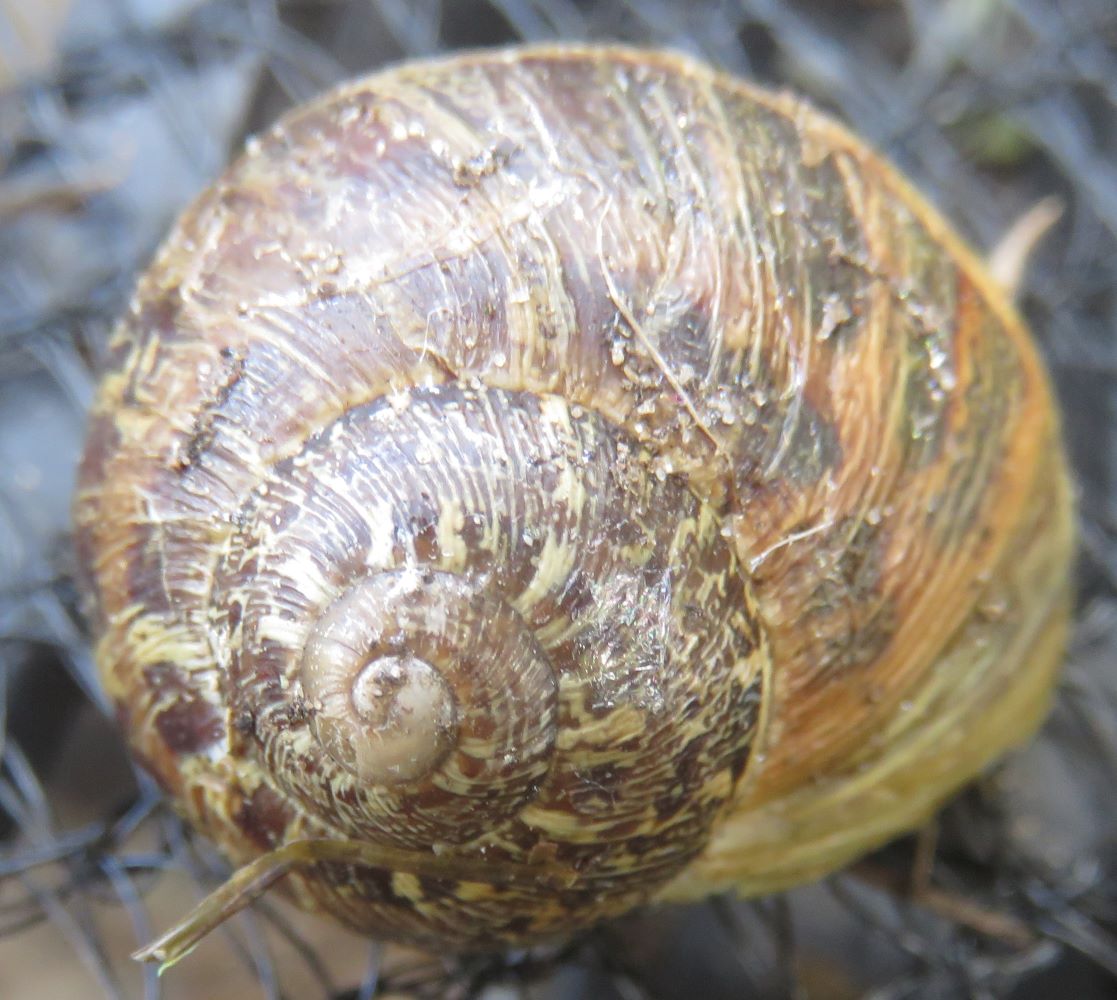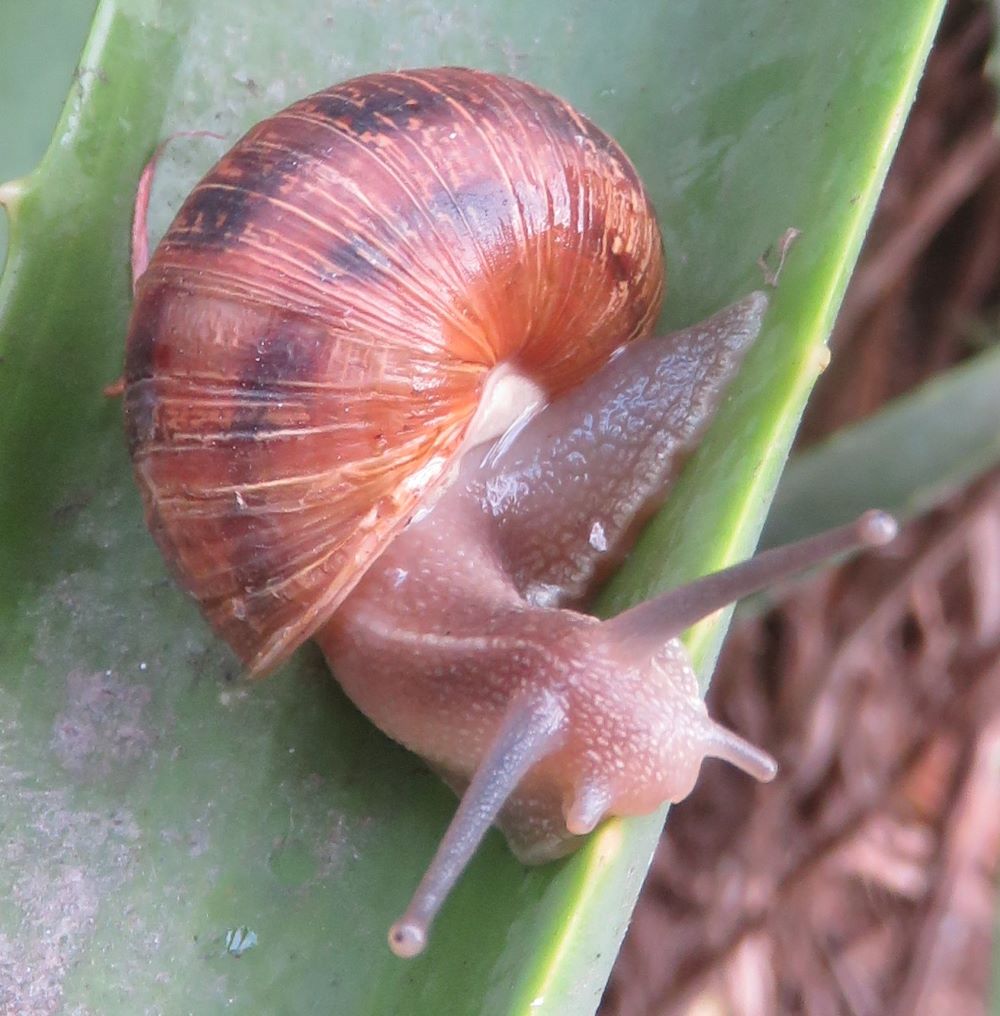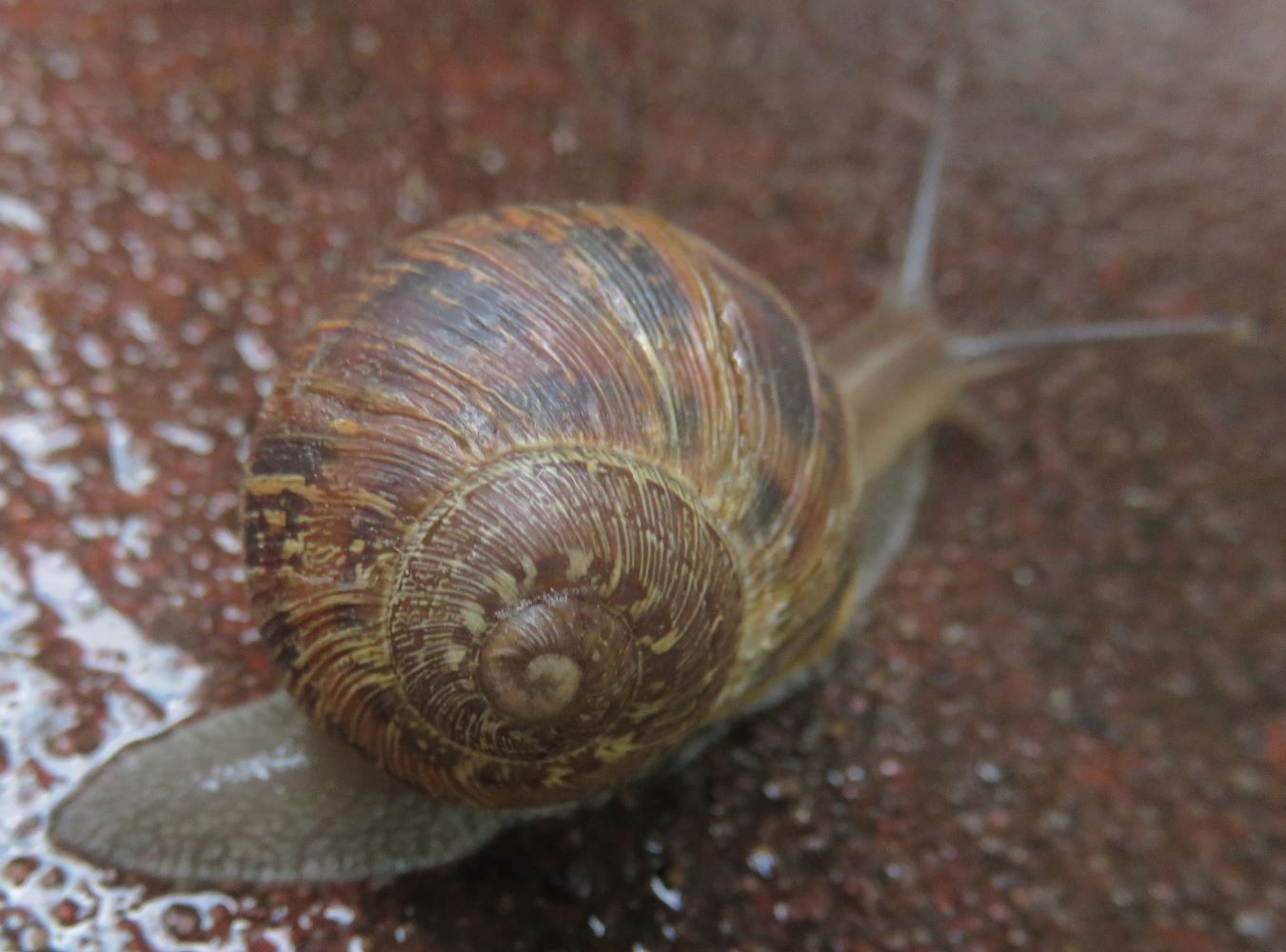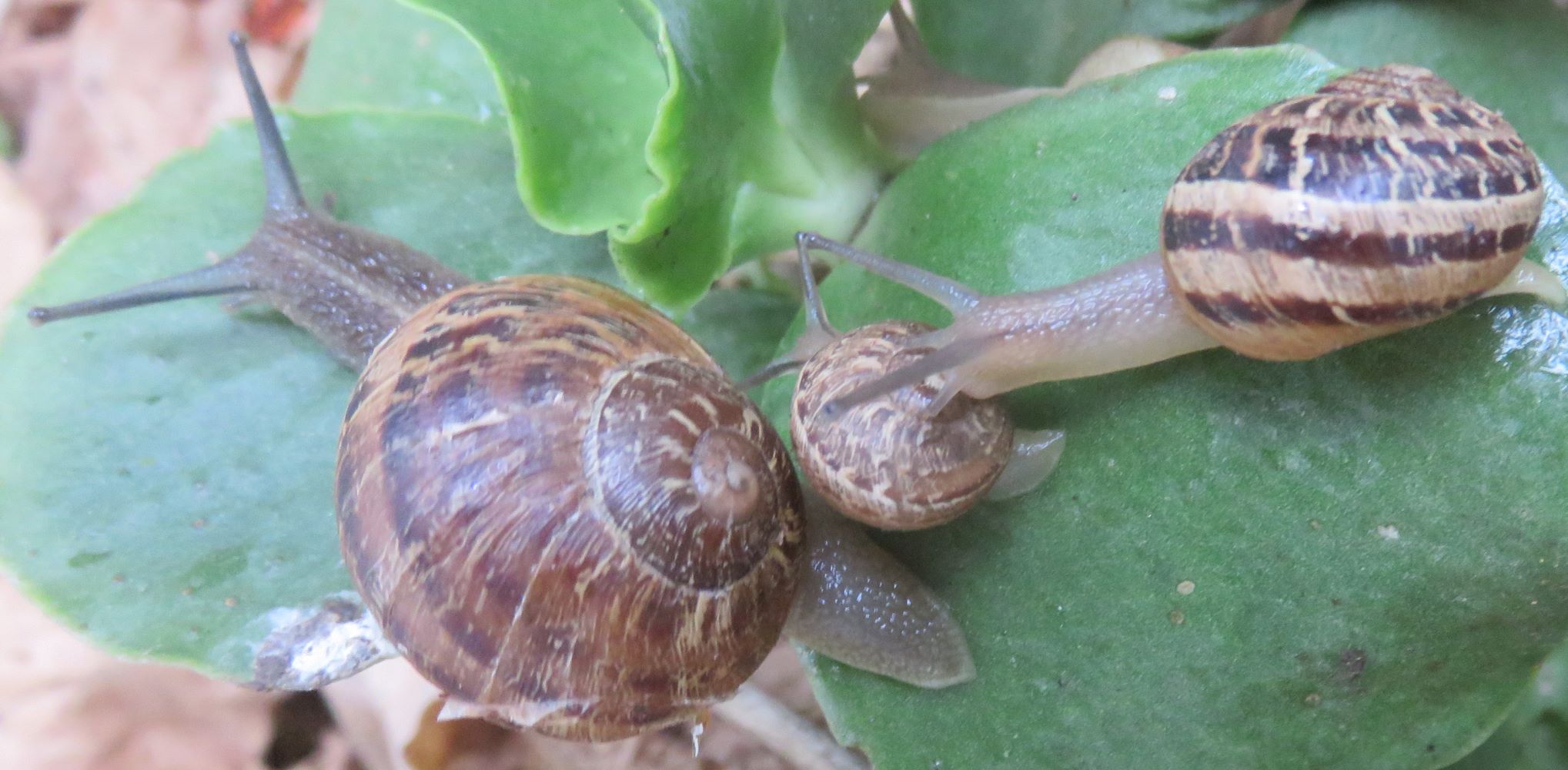Dear Reader, in this age of AI created content, please support with your goodwill someone who works harder to provide the human-made. Sign up at the top of the lefthand column or bottom of this page. You will receive my hand illustrated monthly newsletter RESTORE NATURE and access to the biodiversity garden design course as I write...and nothing else, I respect your time. I am also removing the advertizing as best I can as its become intrusive inappropriate and pays me nothing.
The creation of a snail shell
 A beautiful garden snail shell decorated by radial bands of pigment.
A beautiful garden snail shell decorated by radial bands of pigment.The biggest snail shells
and longest lived snails
We humans treasure the accretions of Calcium formed by large snails, and the bigger sea shells can sell for 100 dollars or more. Sea snails can get very large, the largest, Syrinx aruanus being up to 91cm. Even land snails vary enormously in size. The largest land snail is the tropical Giant African snail or Ghana Tiger Snail Achatina achatina which is up to 30cm. The largest snails of temperate Eurasia are Helix buchi and Helix goderdziana from the Black Sea area, and they may exceed 6cm.
The snail must carry its home everywhere it goes. This could be exhausting, and the life span of most snails is one year in duration, but some of the largest species, such as the Roman snail Helix pomatia, may reach 10 years in the wild and up to 25 years in captivity.
 The snail shell is fused to the mantle which secretes new shell as it grows.
The snail shell is fused to the mantle which secretes new shell as it grows.The forming and growth of the snail shell
Molluscs have a mantle, or thick tissue that covers the internal organs. In the case of snails the mantle is attached to the shell. Glands located in the mantle secrete Calcium carbonate along the margins of the shell, on the open edge of the mouth. This drives shell growth, creating an ever larger shell mouth to accommodate the snail's increasing size. The mantle also coats the inner side with aragonite, which adds strength, reduces friction and helps in shell repair. However, as can be imagined, repair has its limits, takes time, and too much damage is lethal.
 The rich living shell color lies in the periostracum which dies when the snail dies.
The rich living shell color lies in the periostracum which dies when the snail dies.The make-up of the snail shell
What is the snail's shell made of ? Some land snails form their shells mainly from a protein called conchiolin, but the most use a large part of dietary calcium. Low soil pH or calcium deficiency can weaken the snail's shell so that it cracks or has holes in it. This explains why 'my' snails can be found crawling up the wall when it rains and chewing off the house paint.
Sea snail shells are made from less than 2 percent protein and are made mostly of Calcium Carbonate. The snail shell has three layers: the periostracum, or outer layer, is protein based rather than made of calcium, the middle layer, called the prismatic layer, consists of Calcium Carbonate mainly, and the inner layer is often of smooth pearly nacre. Nacre, or true mother of pearl is made of aragonite, a mineral identical in chemical composition to Calcium Carbonate, but having a crystalline structure that is different. The plate like crystals give pearl its luster, whereas the prismatic structure of Calcium Carbonate is generally duller.
In geology, Aragonite is formed deep in the earth under enormous temperatures and pressure, and is unstable at the earth's surface where it quickly returns to Calcium Carbonate. It is not known how shellfish accomplish the formation and maintenance of stable aragonite.
The chemical mechanisms of shell formation are also not fully understood. The outer protein layer provides the matrix on which the calcium can be laid down. Scientists believe that different proteins secreted in the mantle guide the binding of calcium ions to form either Calcium Carbonate or Aragonite, and many shells are constructed of both.
The protein in the shell of sea snails also prevents the shell from dissolving. This protein layer decays when the animal dies, exposing the white calcium based shell beneath.
 Snails grow to all sizes without detaching from the shell. Color variations show differences in diet, genetics and weathering.
Snails grow to all sizes without detaching from the shell. Color variations show differences in diet, genetics and weathering.Shell colors are mostly due to pigments in the prismatic layer or protein layer. Most are regularly deposited, forming radial stripes or spirals of color, or spots. It is thought the coloring may work as camouflage. It is also proposed that they may work as a signal to the snail guiding further cell growth. However some colors appear to have no purpose, existing in the dark of the ocean, or the shell interior.
Snails hatch from the egg with a tiny shell, which grows spirally as the soft body mass of the snail and its mantle increase in size. This is why the spiral at the center of the shell is smaller, as it was made when the snail was younger and smaller. Most land snail's shells have a right hand spiral, or one spiraling outwards clockwise when looking from the top. The increase in size forms a logarithmic spiral. At full adulthood a thick rim may be added to the edge of the shell mouth, the snail stops growing and goes looking for a mate.
------
------

Restore Nature Newsletter
I've been writing for four years now and I would love to hear from you
Please let me know if you have any questions, comments or stories to share on gardening, permaculture, regenerative agriculture, food forests, natural gardening, do nothing gardening, observations about pests and diseases, foraging, dealing with and using weeds constructively, composting and going offgrid.
SEARCH
Order the Kindle E-book for the SPECIAL PRICE of only
Prices valid till 30.09.2023
Recent Articles
-
garden for life is a blog about saving the earth one garden at a time
Apr 18, 25 01:18 PM
The garden for life blog has short articles on gardening for biodiversity with native plants and regenerating soil for climate amelioration and nutritious food -
Cape Flats Sand Fynbos, Cape Town's most endangered native vegetation!
Apr 18, 25 10:36 AM
Cape Flats Sand Fynbos, a vegetation type found in the super diverse Cape Fynbos region is threatened by Cape Town's urban development and invasive alien plants -
Geography Research Task
Jan 31, 25 11:37 PM
To whom it may concern My name is Tanyaradzwa Madziwa and I am a matric student at Springfield Convent School. As part of our geography syllabus for this
"How to start a profitable worm business on a shoestring budget
Order a printed copy from "Amazon" at the SPECIAL PRICE of only
or a digital version from the "Kindle" store at the SPECIAL PRICE of only
Prices valid till 30.09.2023







